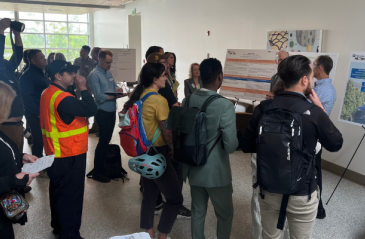
Five things we recently learned about difficult conversations

To what extent can intelligent machines augment - and even replace - lawyers?
Share articleCan a machine can provide better, quicker and more just legal outcomes than a human?
Share articleIntelligent machines can help provide a more responsive justice system
Share articleWe put our vision for government into practice through learning partner projects that align with our values and help reimagine government so that it works for everyone.
Despite the fact that there are now more lawyers than ever before, the law has never been less accessible. This clearly has a profound impact on the quality of citizens' lives. As well as protecting against the infringement of rights, a well-functioning and accessible justice system promotes social order and communicates and reinforces civic values and norms. Furthermore, legal disputes significantly affect the lives of those involved in them.
A recent survey by the Law and Justice Foundation of New South Wales found that more than half of the respondents who had experienced at least one civil problem considered that the dispute had a “severe” or “moderate” impact on their everyday life.
The causes of this inaccessibility are well understood: escalating costs and increasing complexity (both in terms of the law itself and the institutions that apply and enforce it) mean that justice is often out of reach for people of ordinary means. These problems are particularly pronounced for the vulnerable members of our community. A recent inquiry into access to justice by the Australian Productivity Commission revealed that disadvantaged Australians are more likely to be involved in a legal dispute and less well equipped to deal with it. The inquiry argued that government has a role in assisting these individuals.
In many areas of human activity, technological advances have made goods and services cheaper and more accessible. Thus far, however, in law (as in medicine) technological advances have tended to have the opposite effect. A major contributor to this fact is the law's apparent impenetrability. The law is perceived as a complicated organism that requires the costly intervention of legal experts to be accurately deciphered. Accordingly, even as our technology gets smarter and faster, the trend in the law has been for legal services to get bigger and more costly.
But will this always be the case?
Intelligent machines now increasingly shape our society. We routinely rely on algorithms to perform tasks, often with greater precision and reliability than humans. Recent developments in machine learning and natural language processing mean that machines are developing the capacity to approach novel problems autonomously and reason their way to independent outcomes.
No longer restricted to simple, repetitive processes, the new frontier of automation will see artificial intelligence (AI) deployed in complex activities that have until now been regarded as the exclusive domain of the human mind. Against this backdrop, the law - like most fields - is rapidly being confronted with a fundamental question: to what extent should machines augment (and even replace) humans? Put another way, can a machine provide better, quicker and more just legal outcomes than a human?
Generally, there are two ways in which AI can provide a legal service at a significantly reduced unit cost to a much larger portion of the population. Firstly, it can support the provision of legal services; and secondly, it can replace the role of legal experts.
That technology can provide support in the provision of legal services is uncontroversial. We see instances of this type of technology being adopted around the world with ever-increasing frequency. For example, as Sourdin notes, many people now locate legal services online and obtain information about justice processes, options and alternatives through web-based information systems. Sophisticated technologies exist that can organise paperwork and files in disputes to simplify and reduce the time necessary to review and analyse files.
Many courts have also embraced replacement technologies, which are dramatically transforming the way in which disputes are handled. It is now commonplace to find examples of e-callovers, e-filing, video conferencing and entire e-Courts in jurisdictions around the world. All of these technologies have the effect of reducing the amount of time required to process cases and, as their use increases, we should see a concomitant decrease in the unit cost of providing legal services.
However, advancements that chiefly impact the overall productivity of justice systems do not address the underlying complexity of the law. Even technology that supports the more efficient provision of legal services is unlikely to change the fact that most engagement with the law still requires the costly intervention of a legal expert to ensure optimal results. It is here that recent developments in AI can have the most impact. If the legal reasoning process is capable of automation, access to justice would no longer be in the hands of a profession which has a pecuniary interest in maintaining a monopoly over legal services.
Replacing the role of legal experts is, however, a clearly controversial idea. The first objection is that it is simply not possible to automate the intellectual activities central to resolving legal questions. To test this objection, it is necessary to dissect the legal process and understand precisely what occurs when lawyers apply legal reasoning to reach outcomes.
Legal questions can be placed on a spectrum of complexity - determining whether a person is liable for exceeding the speed limit is much easier than resolving whether a person's conduct constitutes a breach of a duty of care.
While the first type of question seems straightforwardly algorithmic in nature (and, accordingly, clearly appropriate for automation), this second class of question involves the application of what Justice Nettle of the High Court of Australia recently referred to as “open-textured laws”. These laws can yield more than one possible outcome, especially in the absence of hard precedent (examples of such open-textured laws are those that include concepts of ‘reasonableness', ‘unconscionability', ‘fit and proper', ‘foreseeability', ‘good faith', etc).
Whether such laws are capable of automation is an unresolved question. It should be noted, however, that recent advances in deep learning and neural networks are increasing the capacity of artificial general intelligence to reason in circumstances that lack clear heuristics. For example, many regard the victory of DeepMind's AlphaGo program over the human champion of Go, an abstract board game that dates back nearly 3000 years, as a watershed moment in the history of AI and something many predicted would be decades away. As Richard Susskind notes, the next decade will be a period of enormous change.
The second objection to supplanting legal experts questions whether it is desirable. While the benefits of democratising legal knowledge are many, the risks must be carefully considered. The law is an evolving organism and our existing systems have checks built into them that would need to be replicated in any new model. For example, when superior courts grapple with cases without clear precedents, they are engaged in a process that concurrently writes and clarifies the law.
This type of rolling evolution is a central tenet of common law systems and allows for instantaneous responsiveness to changing social mores. If legal reasoning were automated, it would be necessary to demonstrate that this responsiveness would not be lost. In embracing a new world, we must be careful not to lose the things we have thus far fought hard to establish and protect.
A legal landscape that embraces intelligent machines has the potential to provide a more responsive and more accessible justice system than ever before. But there are clearly theoretical and practical questions that remain unresolved. Such questions have profound implications and they warrant serious - and immediate - attention from governments.
The Centre for Public Impact is investigating the way in which artificial intelligence (AI) can improve outcomes for citizens.
Are you working in government and interested in how AI applies to your practice? Or are you are an AI practitioner who thinks your tools can have an application in government? If so, please get in touch.












